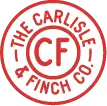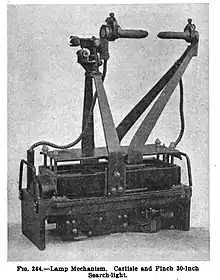Carlisle & Finch
Carlisle & Finch is a manufacturer of nautical equipment founded in 1893 or 1894 in Cincinnati, Ohio, where, as of 2021, it still has its headquarters. It is most recognized today for its searchlights and navigational lights, but is also known as a producer and innovator of electric toy trains in the early years of the company.
 | |
| Type | Corporation |
|---|---|
| Industry | Electrical equipment |
| Founded | 1893 or 1894 |
| Founder |
|
| Headquarters | Cincinnati, Ohio, United States |
| Products |
|
| Website | carlislefinch.com |
Corporate history
The company began as a branch office of General Electric at 182-184 Elm Street, Cincinnati, Ohio, where Robert S. Finch and Morten Carlisle were employed. Work included repairing electrical machinery, including armatures, transformers, and arc lamps.[1][2]
In 1893 or 1894 (sources differ), the shop was purchased by Finch and Carlisle, who intended to continue the repair business and branch out into manufacturing.[1][2][3] The new company was incorporated on April 17, 1897 with Carlisle serving as president.[1][4] In that year, they introduced their first new products, a searchlight based on the carbon arc principle, and a toy train, which also used a carbon arc for its headlight.[5] As the company grew, they added gasoline engines.[1][6][7]
Carlisle sold his share of the business to Finch on August 4, 1926. Brent S. Finch, Robert's son, was named president, and the company started concentrating entirely on its searchlight business. After World War II, Brent R. Finch (son of Brent S.) was hired, at which point three generations of Finches were simultaneously employed by the company. As of 2020, a fourth generation leads the company, with brothers Kurtis B. Finch and Garth S. Finch serving as president and senior vice president, respectively.[1]
A subsidiary company, C&F Polishing, provides metal polishing and restoration services.[8]
Toy trains

One of Carlisle & Finch's earliest products were electric toy trains, and they were the first company to manufacture them in America.[9] The wood and metal trains entered the marketplace c. 1897. They were approximately 5-1/2 inches tall and ran on metal track with rails two inches apart, known as 2 gauge.[4]
Other American companies made toy trains before Carlisle & Finch. Edward Ives, for example, had a factory in Plymouth, Connecticut in 1986. These other makers used wind-up clockworks, steam, electric batteries, or overhead wires to power the cars. Carlisle & Finch's innovation was to use the two rails as electrical conductors.[10]
In 1897, they made a train set with a 4-wheel coal mining locomotive, three coal cars, two zinc carbon elements and a can of chromite. The locomotive included a switch for starting and reversing, and was powerful enough to pull the three loaded cars up a grade. That same year, they also made an "electric railway with double truck car" set, with a car running on two 4-wheel trucks. It was 12 inches (30 cm) long, 5 inches (13 cm) high, and 3.5 inches (8.9 cm) wide, and made of polished brass with iron wheels. It had two motors and could run at 150 feet per minute (46 m/min). Both sets included 18 feet (5.5 m) of 2-inch (51 mm) gauge track.[11]
Searchlights

When World War I started, production was shifted entirely to searchlights, to aid the war effort. The U.S. Government was a major purchaser, with additional large orders from foreign countries including Greece, Spain, Norway, and Russia.[1][12] By 1917, it was one of the few companies worldwide producing searchlights, and had supplied a large proportion of the searchlights then in use by the United States and other countries. They produced a line of commercial searchlights, and also specialized in navy and military designs. Units were built in 9-to-60-inch (23 to 152 cm) diameter, with 2-to-6-mile (3.2 to 9.7 km) ranges. Current draw was 10 to 200 amps.[13]
The earliest models used a carbon arc for the light source. Other companies had previously built carbon arc searchlights, but Carlisle & Finch added the innovation of mounting the carbon electrodes horizontally on the beam axis. The tip of the positive carbon faced the reflector, maximizing the amount of light reflected, and spacing of the carbons was adjusted by motorized screw-feed mechanisms.[14] A manually activated screw moved the entire mechanism forward and backward, positioning the arc at the mirror's focal point. A pair of carbons had a lifetime of about 7 hours.[15]
Xenon arc searchlights were introduced in the 1960s.[16] LED searchlights became available in 2019.[17]
Navigation beacons
Distinct from searchlights, Carlisle & Finch also produced rotating beacons in the DCB (Directional Code Beacon) series starting around 1950.[18] These project a narrow light beam. The light rotates, causing it to appear to flash from the viewpoint of a distant observer. These were originally used as aerodrome beacons, but in the 1990s, the U.S. Coast Guard adopted them for use in lighthouses, replacing existing fresnel lenses. Models include DCB-24 with a 24-inch (61 cm) diameter, DCB-224 with two such lights, and DCB-36 with a 36-inch (91 cm) diameter.[19]
As of 1984 the DCB-24 and DCB-224 were the standard optics used in landfall lights. They have a nominal range of 13–26 nautical miles (24–48 km; 15–30 mi) depending on the rotation speed and whether a colored cover was installed. They could operate in winds up to 100 knots (190 km/h; 120 mph), and included an automatic lamp changer.[20]
Other products

In 1897, Carlisle and Finch offered a hand-powered dynamo, capable of lighting a ten candle power, ten volt incandescent bulb, or to run serval electrical toys simultaneously. They also offered a water-powered version, which produced a similar amount of electrical power from a water faucet supplying 50 psi (340 kPa) of pressure and could be used with as low as 40 psi (280 kPa).[11]
In 1912, they introduced a dynamo driven by a directly-connected gasoline motor. The engine was 1.5 horsepower (1.1 kW), and the dynamo produced 42 volts at 15 amps. A belt pulley was included for driving an external load. The entire assembly weighed 395 pounds (179 kg).[21]
In 1923, a clothes dryer was introduced. The device used a wire mesh drum rotated by an electric motor. Air heated by either gas or steam was forced through the drum, with the temperature controlled by a thermostat. The machine was 30 inches (76 cm) deep, 38 inches (97 cm) wide, 42 inches (110 cm) tall, and weighed 400 pounds (180 kg).[22]
Gallery of early advertisements
 1912: Toy train
1912: Toy train 1913: Searchlights and dynamo
1913: Searchlights and dynamo 1920: Searchlight
1920: Searchlight 1923: Clothes dryer
1923: Clothes dryer
References
- "FIRST in Electric Trains, FIRST in ARC Searchlights! – About The C&F Co. – Brief History". Carlisle & Finch corporate website. Retrieved 2020-11-10.
- "Carlisle & Finch". Kindred Interests. Electrical Review. 24 (11): 134. March 14, 1894 – via Google Books.
- "Miscellaneous Notes". The Electrical World. The W. J. Johnston Company, Limited. XXIIL (4): 134. January 27, 1894 – via Google Books.
- "Carlisle & Finch Trains". The Train Collectors Association. Retrieved 2020-11-12.
- Scott, Sharon M. (2009-12-09). Toys and American Culture: An Encyclopedia: An Encyclopedia. ABC-CLIO. p. 54. ISBN 978-0-313-34799-3.
- "A little bit of history of the Carlisle and Finch company in Cincinnati from 1962". The Cincinnati Enquirer. 1962-07-18. p. 28. Retrieved 2020-11-10.
- "Small Gas Engines". Electrical World and Engineer. McGraw Publishing Company. XLIII (5): 242. January 30, 1904 – via Google Books.
- "Services". C&F Polishing. Retrieved 2020-11-13.
- Walsh, Tim (2005). Timeless Toys: Classic Toys and the Playmakers Who Created Them. Andrews McMeel. p. 14. ISBN 9780740755712 – via Google Books.
- Hoffer, George E. (Autumn 1999). "A Ride on the Lionell and Other Short Lines". Railroad History. Railway & Locomotive Historical Society. 181 (181): 29–30 – via JSTOR.
- "Electrical Toys". The American Stationer. XLII: 309. August 19, 1897 – via Google Books.
- Monk, Dan (July 31, 2000). "The 106-year-old Carlisle & Finch Co. is taking on its global competitors in the searchlight business". Cincinnati Business Courier. Retrieved 2020-11-12.
- Knowlton, Charles Osmond (June 21, 1917). "Naval and Military Searchlights". American Machinist. 46 (25): 1057 – via Google Books.
- "The Carlisle & Finch Search Lights". The Electrical Engineer. XXIV (494): 396. October 21, 1897 – via Google Books.
- Bullard, W. H. G. (1917). Naval Electricians' Text Book: Volume II, Practical (Fourth Edition). Annapolis, Maryland: United States Naval Institute. pp. 381–382.
- "About". carlislefinch.com. Retrieved 2020-11-13.
- "Carlisle & Finch Launches New LED Searchlight". The Waterways Journal. 2019-03-11. Retrieved 2020-11-13.
- Belcher, Chris; Liller, Josh (2020). The Florida Lighthouse Trail. Pineapple Press. p. 238. ISBN 978-1-68334-077-5.
- Jones, Ray (2013). The Lighthouse Encyclopedia: The Definitive Reference (second ed.). Rowman & Littlefield. p. 81. ISBN 978-0-7627-8670-1.
- Aids to Navigation, Technical (including Changes 1 Through 5). United States Department of Transportation, Coast Guard. 1986. pp. 6-85 to 6-89.
- "Direct Connected Gasoline Engine and Dynamo for Farm and House Lighting". Electrical Record: 149. September 1912 – via Google Books.
- Electrical Record and Buyer's Reference. Buyers' Reference Company. June 1923. p. 361.
External links
- Company web site
- Cowell, Gerald W. (December 1972). "The Amazing Carlisle & Finch". Cincinnati. Vol. 6 no. 3. Greater Cincinnati Chamber of Commerce. pp. 42–44. Retrieved 11 November 2020.
- Loveland, Frank. "Research Notes on Carlisle & Finch". Tinplate Times.